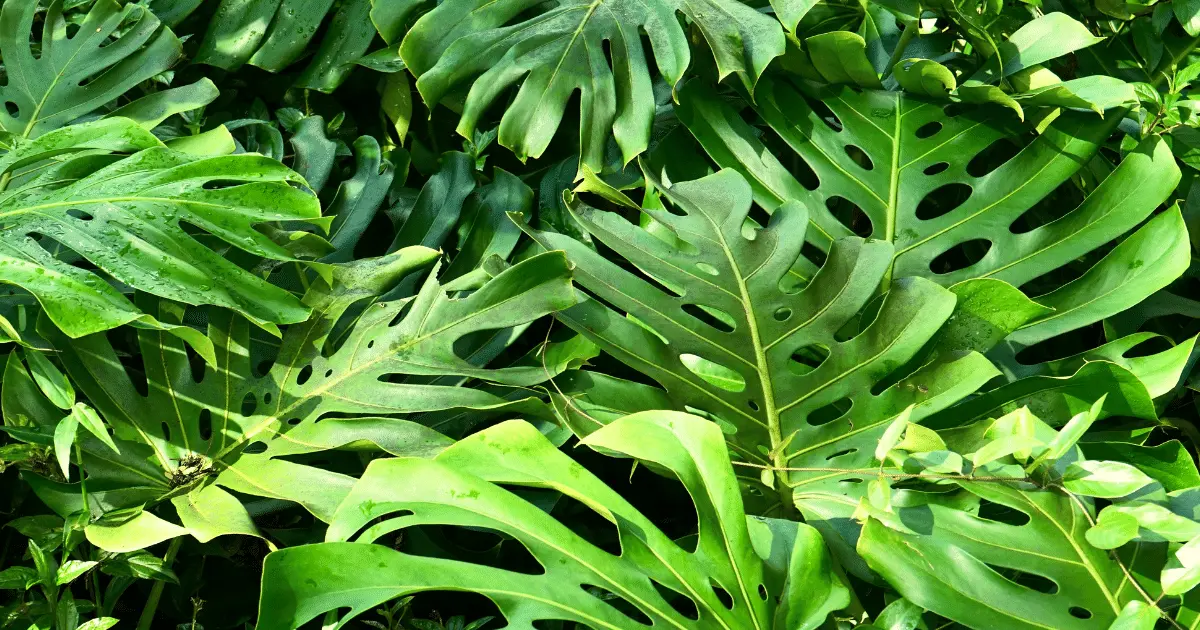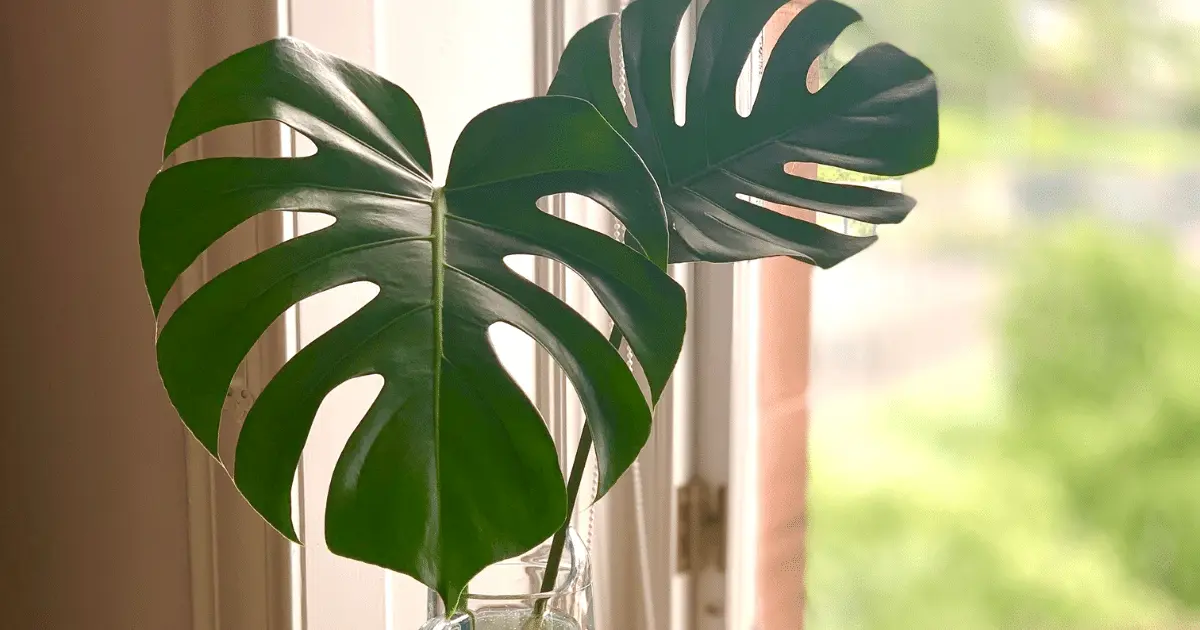The monstera plant is, beyond doubt, one of the most popular houseplants there is. Nicknamed the ‘Swiss cheese Plant, monstera plants are famous for their natural holes and grooves developed as they mature.
However, they only sometimes look as good as they do in pictures. Like other household plants, they often encounter problems like yellowing leaves.
Causes of and Treatment for Monstera Leaves Turning Yellow

There are different reasons monstera leaves turn yellow. Below are some of the most common reasons why these leaves turn yellow and how to fix them.
1. Watering problems
When it comes to watering, monsteras can be a bit tricky. Their roots will rot, their leaves will turn yellow, and the whole plant will die if exposed to too much or too little water.
Under-watering
Feeding your monstera plant with too little water can cause its leaves to turn yellow. You can spot an under-watered monstera plant by its dry soil, yellowing leaves, drooping leaves, and, ultimately, leaves turning brown and crispy.
When monstera plants go dry, they usually need thorough watering to get back in shape. You should move your plant to a place where you can give it lots of water, like outside the house with a hose.
Treatment for under-watering:
Water the soil until water begins to run through the bottom of the pot, then keep watering it for a bit longer. When the monstera soil completely dries out, it becomes hydrophobic. It will not absorb water as it should, so you need to feed it with more than enough.
After watering, pay attention to the plant’s soil moisture and yellowing leaves. You may also need to change your watering schedule to be more frequent.
Over-watering
Over-watering occurs due to water-retentive soil and watering too frequently. It is not caused by how much water your monstera plant receives per time.
To know if your plant is over-watered, its leaves will become droopy, develop brown spots and turn yellow. You should also inspect the soil. Stick a finger into the soil and confirm if it is wet, soggy, or smelly. If you answer yes, your monstera has developed root rot from excess watering.
Treatment for over-watering:
Move the monstera plant from the pot it is in into a new one, preferably with good draining holes. You will also need to cut out all rotting roots and apply a fungicide to prevent the spread of it when transplanted.
2. Pests
Weakened indoor plants are susceptible to pest infestation, which drains out essential nutrients from the plant and causes yellowing leaves. The damage in monstera plants by pests is caused by pests such as aphids, spider mites, fungus gnats, and mealybugs, and these pests suck out the sap from plants.
And when pest infestation is not taken care of, the whole plant could die.
Treatment for pest infestation:
An easy way to get rid of the most pests in monstera plants is to spray the plant with bug spray or a soap-water solution. You can also use neem oil to get rid of the pests. Or, you can follow a pest eradication program.
3. Fungal Diseases
Some diseases cause monstera plants to turn yellow. There are three fungal diseases to consider when you notice yellowing leaves in monstera plants; powdery mildew, anthracnose, and fungal leaf spots.
Powdery Mildew
Powdery mildew produces a white, powdery-looking coating on monstera leaves, and they can be easily identified because of this. Powdery mildew is not deadly to plants; however, the fungus can make the leaves turn yellow and dry out if neglected.
Treatment:
To treat, cut out the infected parts of the monstera plant. Then, use a fungicide to eliminate what is possibly left off the powdery mildew. Lastly, you should ensure free airflow and reduce the plant’s moisture to ensure it does not return.
Anthracnose
Anthracnose is a fungal disease that thrives in wet environments. You can identify this disease in brown or yellow spots on leaves. If left untreated, the infection progresses, the yellow spots turn brown, and the splotches. The Anthracnose fungal disease can also cause brown, cankerous lesions on the stem.
Treatment:
Cut off infected leaves and stems with a pair of pruning shears. Sterilize the shear between cuts by dipping it in rubbing alcohol or hydrogen peroxide.
And if you missed some leaves that had no symptoms, spray a copper-based fungicide.
4. Fungal Leaf Spots
Fungal leaf spots occur when a fungus begins to eat the leaf of a plant from the outside. The disease-causing fungus makes a cluster of yellowing spots on the leaves. And in the middle of the yellow ring will be a black or brown fungal dot. A more obvious defect will begin to look like concentric circles.
Treatment:
Cut out infected leaves to prevent the spread of the disease. Then, use a copper-based fungicide to get rid of the remaining fungus.
5. Lighting conditions

The monstera plant does not thrive in extreme light conditions but can also wither and die if exposed to poor light conditions. Monstera leaves can turn yellow under poor and extreme light conditions.
The monstera plant prefers bright indirect light.
Too Little Light
Your monstera plant needs to receive more light to turn its leaves yellow directly. Rather, watering the plant too frequently under poor lighting conditions causes the leaves on the plant to turn yellow.
Other signs of too little light include; stunted growth, smaller leaves with less fenestration, or none at all, and etiolation.
Treatment:
If you notice signs of distress in your monstera plant due to too little exposure to light, find a new position for your plant. Placing the plant closer to a light source is best. And if that is not an option, you should buy a grow light for your monstera plant.
Too Much Light
Despite being a tropical plant, monstera thrives under low light. As mentioned earlier, they thrive under bright indirect light, and too much light can burn the leaves on your swiss cheese plant.
When monster leaves get burnt, the burnt spot turns brown or black, and the areas surrounding the leaves turn yellow.
Treatment:
Cut out the affected leaves, and move the plant a few feet away from where it is receiving too much light.
6. Low Humidity
As hardy plants, monsteras require higher humidity than most other houseplants.
Yellow dry leaves are signs of a dry monstera plant. Once they turn yellow, the leaves will likely become brittle, brown, and wither.
Treatment for low humidity:
Misting the plant once a day, especially during the winter when you may have your heater on more often, can help maintain humidity levels.
If misting is not an option for you, you can keep your monstera plant in the bathroom to provide it with humidity from your showers or baths.
7. Transplant stress
If you have just recently repotted your Swiss Cheese plant into a new container, the transplant stress could cause the leaves to turn yellow.
Monstera plants are highly sensitive to stress. They can get stressed if they are repotted at the wrong time, if there is a change in soil, or if their roots have been exposed to air for too long.
When a monstera plant experiences this stress, the leaves turn yellow, starting from the oldest. And in addition to this, their petioles droop, and they lose their leaves.
Treatment:
You can help reduce stress for your monstera plant after repotting by continuing to water the plant regularly and putting it back in the same spot it was before. Be sure to avoid adding too much or too little water, and do not expose it to too much light as it might stress the plant more. You should only fertilize the plant once it has recovered and begun growing fine again.
8. Nutrition deficiency
An imbalance in the nutrition supplied by your fertilizer can also cause yellowing leaves in monstera plants.
This can occur when the plant is fed with too much fertilizer, and the salt in it burns the plant or a nutrient deficiency. Each of these conditions has its symptoms and diagnosis.
Over-fertilization
Over-fertilization occurs when too many nutrient salts accumulate in the plant’s soil, pulling water away from the plant’s roots in reverse osmosis.
Too much fertilizer also alters the soil’s acidity. Too much salt in the soil causes a condition known as Salt Burn, resulting from chemical dehydration.
When your monstera is being over-fertilized, you’ll notice a white crust of excess fertilizer on the soil’s surface, the edges of the leaves turning brown and becoming crispy, yellowing leaves in the oldest leaves, and stunted growth.
Treatment for over-fertilization:
Over-fertilization is easy to treat once you’ve identified it as the problem. Give your plant a long shower to flush out excess nutrients from the soil.
To prevent over-fertilization from occurring again, switch to a gentle organic fertilizer, and reduce the quantity and frequency of fertilizer application.
9. Nutrient Deficiency
Plants can also suffer from a nutrient deficiency when not fed properly. The major nutrients your monstera plant needs to survive are; Nitrogen, potassium, and phosphorus, and a deficiency in any of these nutrients affect your plant differently.
If your plant has a nitrogen deficiency, your Monstera plant may experience stunted growth. Its leaves will grow lighter in color, with the oldest leaves on the bottom of the plant turning entirely yellow.
And if it is a phosphorous deficiency, your monstera will also experience stunted growth. If the condition is left unattended, it worsens with the leaves and stems darkening and developing a reddish or purple discoloration. This deficiency does not cause the leaves on the plant to turn yellow.
A potassium deficiency causes the leaf edges of the swiss cheese plant to turn brown and yellowing in the oldest leaves.
Treatment for nutrition deficiency:
To correct this deficiency, feed your plant with an organic fertilizer with a balanced level of these nutrients.
